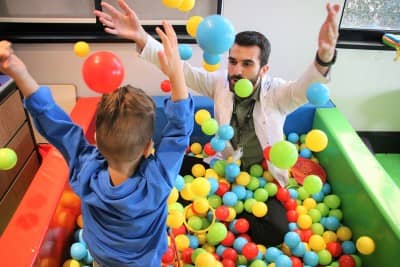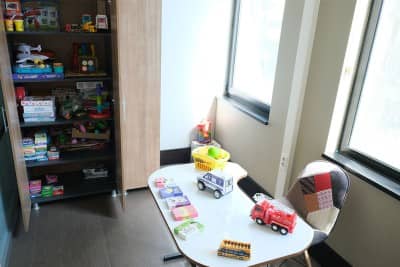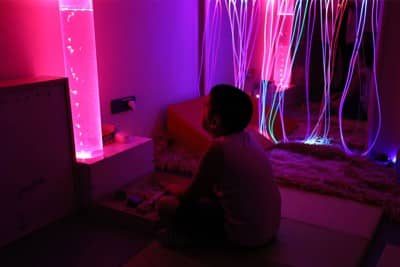- E-Magazine
Contents
What does it do?
Child and Adolescent Development & Autism Center (ÇEGOMER) , which serves at Np Feneryolu Medical Center , is a center where rehabilitation programs that support daily life, academic and social skills for Autism Spectrum Disorder, Attention Deficit and Hyperactivity Disorder, Specific Learning Disorder, Communication Disorders, Mental Disability, Motor and Tic Disorders under neurodevelopmental disorders are created and developmental follow-up is carried out and implemented.
The programs of the center, which keeps the health and education pillars together; early childhood program, pre-school and school program, home follow-up programs. The early childhood program aims to provide early childhood education, communication and interaction skills, play skills, learning readiness skills, parental relationship, daily life skills such as nutrition, sleep, toilet and sensory acquisition with the staff of child adolescent psychiatrist, special education teacher, sports movement education specialist, clinical psychologist, speech and language therapist and expert occupational therapist.
The program, which can be planned as a full or half-day program according to the needs of the child; pre-school and school programs, participation in pre-academic and academic skills, managing daily life skills, self-care, participation in play, productive and leisure activities, social interaction and communication skills.
Autism spectrum disorder is a type of verbal and behavioral disorder that is either congenital or has a negative impact on the quality of life throughout a person's life. Early diagnosis and rehabilitation are very important in autism, which is considered a mental disorder. It manifests itself with recurring behavioral symptoms in the first 3 years of life. There is no treatment method to completely overcome autism. It is possible to minimize the effects of the disorder that prevent the person from leading a quality life and socializing in society. Different drug therapies and rehabilitation methods are of great benefit at this point.
Autism is an important neurodevelopmental disorder with symptoms in early childhood. Atypical autism is a disorder that is similar to autism in some aspects, but is not positioned under one of the disorders in the spectrum of pervasive developmental disorders. It is less severe than autism. In some cases, it can be observed quite far from autism. Autism is 3-4 times more common in boys than in girls. While symptoms of autism begin early in the developmental stages in some children, in others, there is a regression or disruption in the normal course of development. The suspicion of autism arises when the child's speech is delayed or the child is unresponsive and uninterested in the environment. The family applies to a specialist because the child does not utter any words even though his/her peers do, or because the child can say single words such as "mom, dad" but has forgotten these words in recent months.
What are the Symptoms of Autism?
A baby bornwith autism is no different from a healthy baby. Of course, this is valid for the first months. It appears after a certain period. After birth, there is no abnormal situation in the baby for a while. But as the baby starts to grow, symptoms of autism appear. Autism symptoms are observed by examining three areas. They are autism symptoms detected by repetitive behaviors, communication and social interaction. Autistic children show many of the symptoms listed below;
- In autism symptoms, inadequacy in social interaction and communication is observed.
- They may not make eye contact at all.
- They usually do not use gestures and mimics.
- They do not react when their name is called or spoken.
- Insensitivity to the attention of people and family members can be observed.
- They may not be able to establish relationships with their peers and may have difficulty in doing so.
- Delay in language development and speaking skills may be observed.
- May be uninterested in games and activities.
- May have problems in establishing and maintaining communication.
- May be insensitive and indifferent to toys.
- They may be overly insistent and react to things they do routinely.
- They may overreact to changes and what is being done.
- They may attribute different purposes and qualities to the objects around them.
- Makes repetitive movements such as spinning and rocking.
- Has difficulty adjusting the tone of voice when speaking.
- May be excessively mobile or completely immobile.
- May show hypersensitivity when exposed to situations that can be sensed with the five senses, such as sound, light, pain and smell.
- May show or act intolerant to certain situations.
- They may be overly interested in some unusual subjects.
In the special education phase of the child's education, responsibility should be shared and should not fall on one of the couple. Family members should support each other. The whole family should act together for the child's language development, social adaptation, awareness within the family and harmony with the environment. Most children with this disorder have mental retardation. In addition, neurological diseases such as epilepsy can also be detected in some children with this disorder. Therefore, we can list the situations that families should pay attention to as follows;
- Absence of the pre-speech period between 6-9 months of babies or low sounds compared to peers
- Little interest in the voice and face of the caregiver
- Lack of eye contact and mutual smiling
- Don't look at the name
- No expectation of being held and playing with other people
- Excessive and atypical interest in certain objects or parts of them (examining objects by holding them strangely close to the eyes)
- In 20-47% of children with autism, regression begins after the age of 1 after normal development.
What is Autism?
Autism Spectrum Disorder (ASD), or pervasive developmental disorder as it is also known, is one of the neurodevelopmental problems of childhood. Symptoms generally manifest themselves in early childhood. While some children experience disruptions in their development, others may show normal development at first and then regress after a while.
Although autism was defined as a rare disorder in the 1970s, its prevalence has increased considerably in the 2000s. According to the data of the Center for Disease Control in the United States, while it was 1/150 in 2006, higher rates such as 1/64 in 2014 are mentioned. When the reasons for the increase in the prevalence of autism are investigated, the increase in awareness about the diagnosis, the fact that cases with mild symptoms are not missed and are evaluated within this disease group, and the increase in the frequency of becoming parents at a later age can be counted. However, it is thought that there may be other unknown reasons for the increase in frequency.
What Causes Autism?
The cause of autism is not yet fully known. It is thought that a large number of genes are responsible for this disorder and drugs that affect the disorder in genes are being developed to treat the disease. It is predicted that these treatments will produce positive results in some of the children with autism in the coming years.
After studies on twin children, it has been observed that this disorder is not entirely due to genetic factors and is also not entirely linked to environmental factors. After all the studies, it has been stated that this disease occurs during meiosis. This means that each person is at risk of autism at birth. Each individual carries the genes that cause this disorder at birth.
How is Autism Spectrum Disorder Diagnosed?
Autism spectrum disorder cannot bediagnosed by blood-urine analysis or brain imaging, meaning that there is no normal or abnormal process in body fluids and tissues that can be used for diagnosis. The diagnosis is based on clinical observation and behavioral characteristics. Autism symptoms usually start to be observed around the age of 2 and the diagnosis can be made. However, with good clinical observation, symptoms can be detected even in a 1-year-old child. It is not possible to detect autism in the womb. Therefore, families often raise the question of how to treat autism when their children are diagnosed with autism.
How is Autism Spectrum Disorder Test Conducted?
Autism spectrum disorder covers a range of neurodevelopmental disorders , including classic autism, Asperger syndrome or Rett syndrome. It is applied with the interaction of the parent and pediatrician.
The autism screening test is a test for children aged 4 years and older and consists of 40 questions on communication skills and social structure.
In the screening test for 2 years of age; imitation, attention control, play and motor skills are observed.
How to Prevent Autism Spectrum Disorder?
There is no known way to prevent autism spectrum disorder, but there are various alternatives that are applied to better adjust daily life. Early diagnosis and timely and appropriate intervention is one of the most effective methods. Early diagnosis of autism can contribute to children's movements, skills and language development.
How is Autism Spectrum Disorder Treated?
Autism spectrum disorder is treated by informing the family about autism after the diagnosis is made and the correct education program is applied to the child as soon as possible. The most important education is applied behavior analysis. In addition to individual education, which has been scientifically shown to be effective in autism, speech training and sensory integration therapy at the appropriate age are among the recommended methods. It is important for the family to participate in the education program and to support the child in social-emotional areas outside of education.
No effective drug treatment has yet been found for the basic symptoms of autism. However, medication may be necessary for some children with autism due to accompanying attention deficit, behavioral problems, sleep problems and anger control problems.
Autism is a disorder whosetreatment should continue for years, so it is extremely important that the family is informed about this issue. In a small number of cases, it has been found that the diagnosis completely disappears with short-term and early education. In most cases, many years of education are required. Normal intelligence, mild symptoms and development of speech skills before the age of 6 are good prognostic indicators. Scientific studies have shown that methods such as diet therapy, hyperbaric oxygen therapy, heavy metal detoxification and neurofeedback are not effective. Early diagnosis and treatment is very important to reduce the symptoms of Autism and improve the quality of life for individuals with Autism and their families. There is no medical test for autism. It is diagnosed by observing how the child speaks and moves compared to other children of the same age. In this context, the effectiveness of Transcranial Magnetic Stimulation (TMU) treatment method is being investigated. The results of this research will shed light on the question of how autism is treated. There are many therapy methods applied in the treatment of autism. We can list these therapy methods as follows;
Sensory integration therapy: Sensory problems reduce the individual's harmony with the environment and prevent them from exhibiting appropriate behaviors. It reduces the individual's adaptation to life, prevents him/her from showing daily life skills, makes it difficult for him/her to achieve academic learning and causes problems in self-care. Recent studies answer the question of how autism is treated. With the integrative approach of sensory integration therapy, the behaviors of the individual are improved and it can help to ensure the formation and control of the self. It provides treatment support in minimizing the specified problems.
Auditory integration therapy (AIT Auditory Integration Training): Auditory integration therapy determines which frequencies the child is hypersensitive to. Then, during the therapy sessions, music that has been cleaned of these frequencies is played to the child through headphones. There are also studies showing that this method reduces hypersensitivity to different sounds and behavioral problems.
Music therapy Music therapy is a therapy method applied by specialized therapists with the help of activities such as singing together and using musical instruments.
Music therapy helps the child develop an emotional bond with the therapist and other people. Using a musical instrument, singing or dancing can help the child develop a sense of achievement.
Art therapy: In art therapy, plastic arts such as painting, ceramics, sculpture, etc. mediate self-expression. It is aimed to make the person emotionally happy. It tries to ensure that the feelings and thoughts that the individual cannot reveal in different ways are revealed through artistic works.
Drama therapy: The main purpose of drama therapy is to help individuals to develop emotionally and express themselves by applying activities such as role playing, storytelling, etc. in performing arts. During drama therapy, non-movements are transformed into various creative behaviors. The main aim of the therapy is to contribute to the person's creative mind. By using objects as tools through different play methods, relationships with people are tried to be improved.
Animal therapies: In the treatment applied to children with autism, interaction between the child and the animal is tried to be established. In this way, it is aimed to provide sensory development. There are many different types of applications. In ongoing studies on these therapies, it is thought that they may be especially useful in reducing the anxiety and stress levels of children with autism.
Mild, Moderate and Severe Autism Degrees
Autism is a pervasive developmental disorder that develops from the first 2 years of life. People diagnosed with autism have symptoms such as difficulty in understanding social relationships, problems in language development, inconsistency in mental functions and insensitivity to sensory reactions. Each of these symptoms can be observed or only some of them can be observed. The degrees of autism differ from one another because the symptoms can be seen at different levels in each individual. Therefore, autism education for each person is not the same. For more detailed information, we can list the types of autism as follows;
Asperger's Syndrome: It is called a number of neurological disorders. It is characterized by difficulty in communicating with people. This type of autism does not cause regression in language and mental development. It does not cause any weakness in grammar, vocabulary and verbal areas in individuals with this disease. However, there may be weakness in visual and perceptual areas.
Childhood Disinteragrative Disorder: In children with this symptom, development is observed normally for at least 2 years. However, with the onset of the disorder, the accumulated knowledge is rapidly lost. Mental retardation is also observed in this type of autism along with the retardation in mental skills.
Atypical Autism: In addition to difficulty in speech, ongoing conversations, problems in social life and developmental disorders are observed. Symptoms appear at an early age. However, in some cases it is not possible to make a complete diagnosis. Problems can also be eliminated by receiving a good education. The type of autism most suitable for treatment is atypical.
Reet Syndrome: It is a genetic autistic spectrum disorder that occurs in girls. In addition to occurring in the first 5 months after birth, head growth slows down. But it manifests itself with obsessive hand movements. As time passes, personal skills regress. This disease, which occurs with conditions such as medications and attention deficit, can respond positively to behavioral education and special therapies.
Signs of Autism in Boys and Girls
This disorder is more common in boys than in girls. Signs of autism in boys and girls are of two different types. First, we can talk about autism signs in the field of social communication and interaction. Here, the child is expected to recognize his/her family, make eye contact and listen when called. But children with autism do not react to these situations. Another type of autism sign is repetitive movements and behaviors. These behaviors are movements such as turning around, swinging. In addition to these, in order for boys and girls to be diagnosed with autism, they must show some signs in early childhood. Sometimes, these signs may not be recognized until school age.
If children have these signs of autism, it is critical that they are evaluated by a specialist for early diagnosis. The child should be seen by a specialist and treatment should be started. After the symptoms are examined and the diagnosis is made, the main task here falls to the family and the educator. Autism is supported by special education. At this stage, couples should act together as much as possible and should not take an accusatory attitude towards each other and try to remain calm.
Hypotherapy
The hippotherapy device is a strategy that utilizes the movements of the horse to achieve functional improvement and development in groups of children and adolescents with sensory or mental disorders. The horse's movements are variable, rhythmic, repetitive and multidirectional. The horse's movements provide vestibular, proprioceptive and tactile stimulation. It supports joint mobility by improving muscle strength. Studies are carried out to support balance, coordination and body awareness. As a result of the exercises, coordination, concentration and interaction between movements are provided. Rhythmic movements of the horse help to improve postural control, body awareness, ease of motor planning, balance, coordination, timing, sensory integrity and attention sustainability.
Robotic Hippotherapy Device Application Areas
- Autism Spectrum Disorder
- Attention Deficit and Hyperactivity Disorder
- Specific Learning Disorder
- Down Syndrome
- Musculoskeletal System Diseases
- Cerebral Palsy
- Mental Retardation
- Learning Problems
- Speech Disorders
- Developmental Delays
- Sensory motor dysfunctions





